Secrets of Caodaism: Discover Vietnam's Spiritual Oasis and Its Extraordinary Traditions
Hola! Amigos,
Spring is in full swing all over the northern hemisphere. Preparations for Easter and today's celebration of the end of Ramadan - a month-long fast in the Islamic religion - Eid al-Fitr, prompted me to write an article about a little-known religion - Caodaism.
And by the way, to my friends from Indonesia, Malaysia and Pakistan, I wish you - Eid Mubarak! May this special day bring joy and peace to your lives.
I remember my first months in Viet Nam and the surprising, colorful temples, which, as it turned out, I mistakenly thought were Buddhist pagodas. I had heard something about a "strange variety of Buddhism" popular among the locals, but I ignored this thread in my travels. Until now.
When planning a weekend trip out of town, the choice fell on the highest mountain in southern Viet Nam, Bà Đen. This 996-meter-high peak, called the Roof of the South, is a remnant of a once active volcano. It towers over a flat area of rice fields and is one of the attractions in the area. It is one of the theme parks of Sun World, the same company that manages the Bana Hills in Da Nang and the parks on Phu Quoc Island. At the same time, on the slopes of the mountain, there is the Bà Đen Pagoda, to which millions of Buddhists make pilgrimages. The Black Madonna, the statue on the top and beautifully arranged gardens complete the list of attractions of this place. I have visited this place twice and there was always something to do.
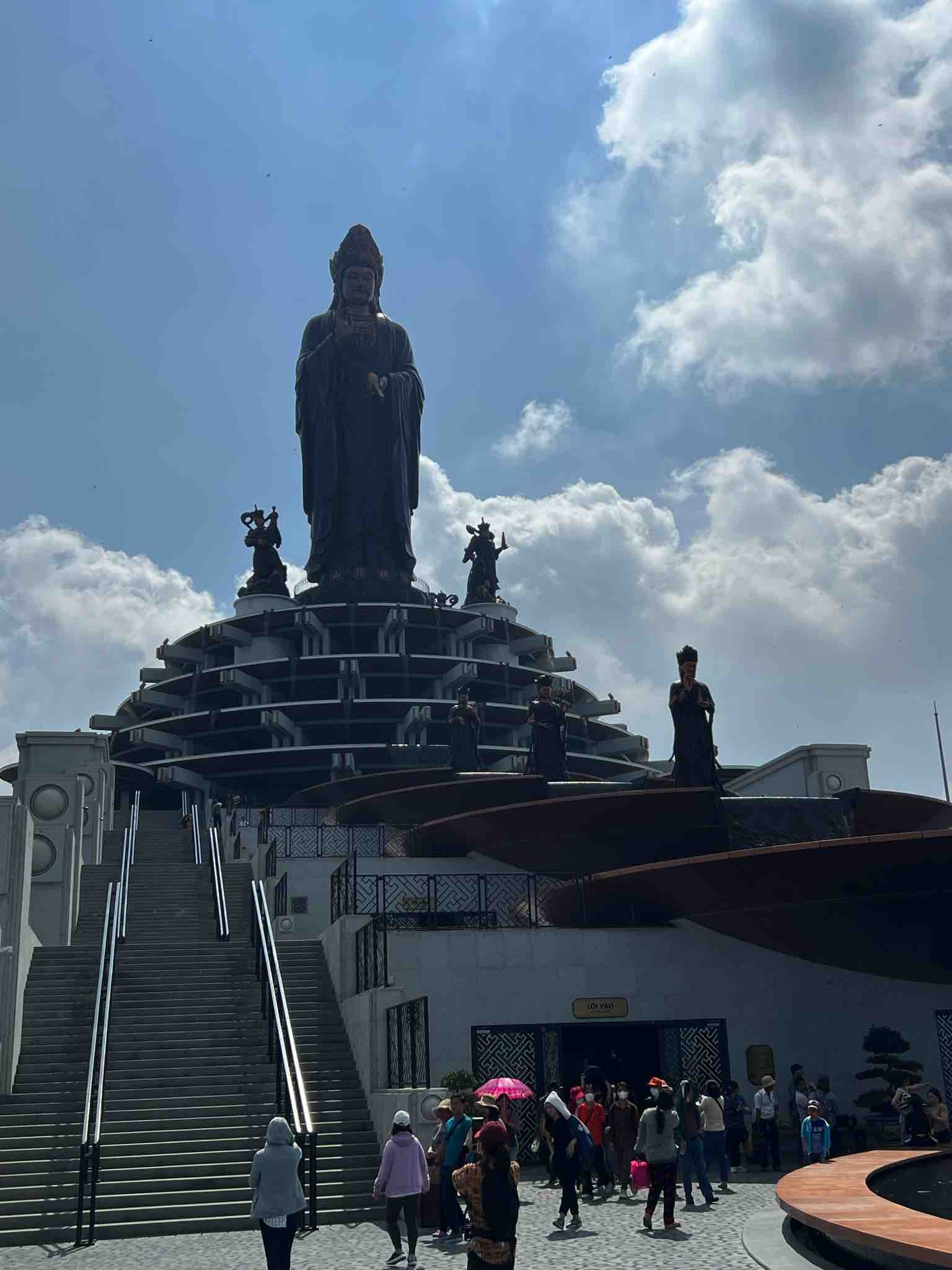
What's more, I learned that it is in the vicinity of Bà Đen that the center of the local religion is located - the goal of my trip. Coincidence? Or maybe fate...
I decided to visit this place right after visiting Bà Đen.
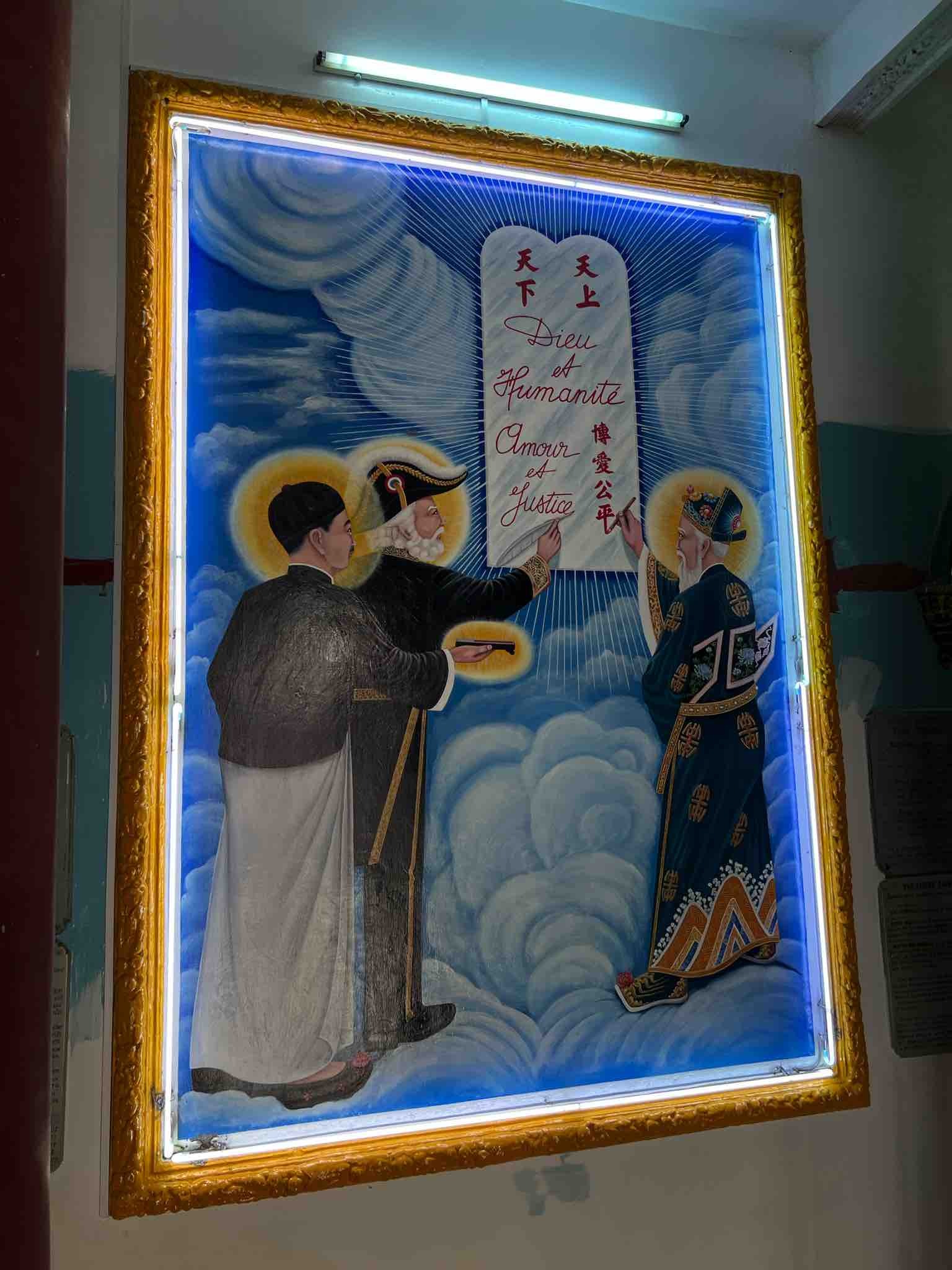
The Great Cao Dai Temple – the heart of Caodaism
I am currently at the Great Cao Dai Temple in Tây Ninh – the spiritual centre of this religion, a place full of colour, mystical symbols and harmony of different traditions. Viet Nam, as the homeland of Cao Dai, has played a key role in its development. The religion was an important part of national identity, especially in the 20th century, when its followers played an important political and military role. Today, it is a testament to a unique spiritual path, connecting the East and the West in the search for unity and enlightenment. Its colourful, ornate architecture combines influences from different religious traditions, and the ceremonies held there attract both believers and tourists from all over the world.
Cao Dai is a syncretic religion that was born in Vietnam in the 1920s, combining elements of Taoism, Buddhism, Confucianism, Christianity, Islam and local folk beliefs. The founder of the movement was Ngô Văn Chiêu, a Vietnamese colonial official who claimed to have received a divine revelation that inspired him to create a new religion. The main goal of Cao Dai was to spiritually unite humanity and spread peace and moral values. He believed that God spoke to people through a medium and showed them a new spiritual path that would unite the different religions of the world.
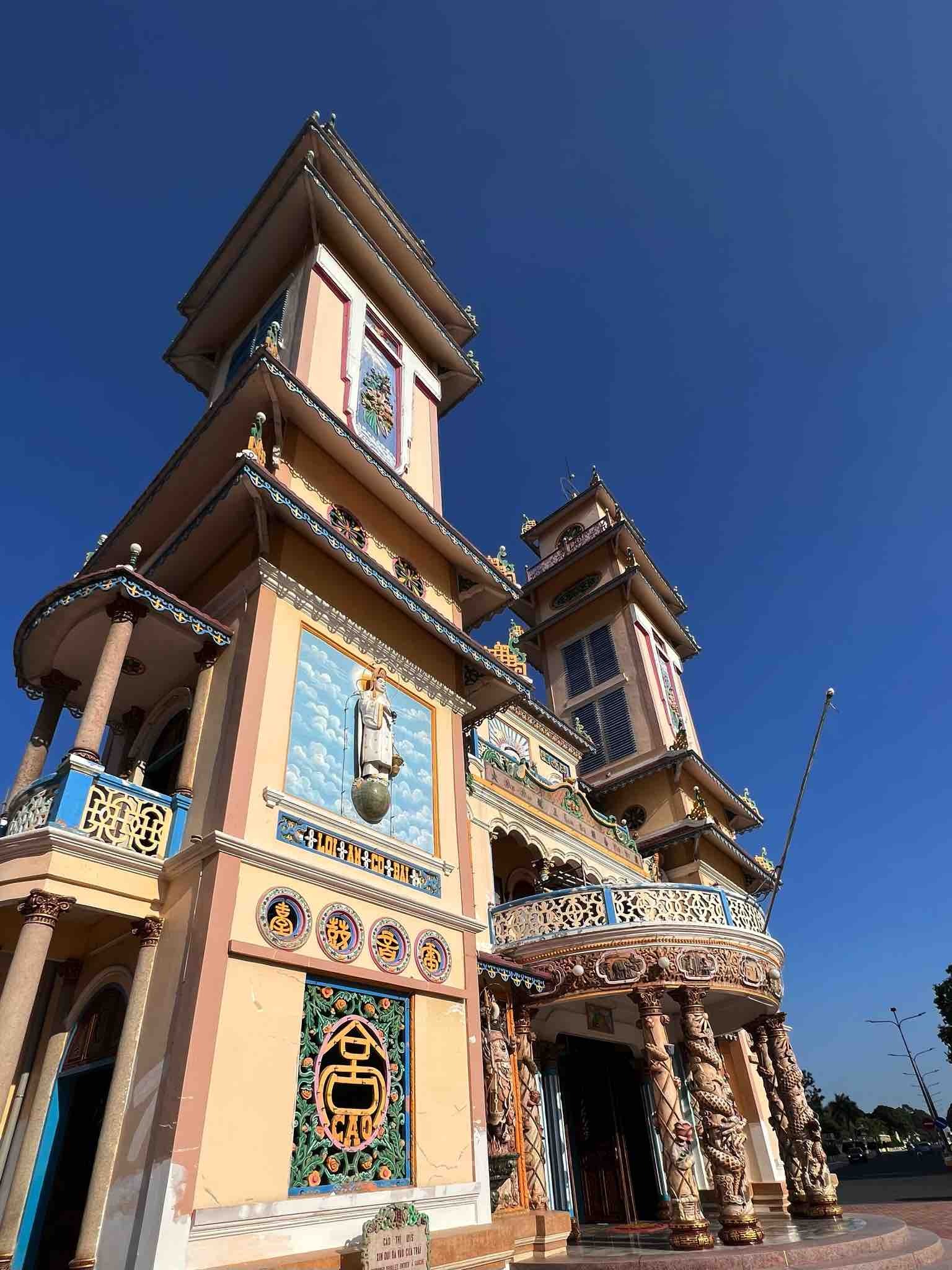
The co-founders and early leaders of Cao Dai were also Lê Văn Trung, a former politician and businessman who became the first Giao Tông (pope of the religion), and several other prominent Vietnamese spiritual leaders, such as Phạm Công Tắc, who is considered one of the main organizers and developpers of the religious structure.
The founders of Cao Dai were inspired not only by traditional East Asian beliefs (Buddhism, Taoism, and Confucianism), but also by Christianity and spiritualism, which was popular in Europe and France at the time. The religion arose in the context of the Vietnamese quest for spiritual and national independence during the French colonial era, and therefore also had a strong patriotic and social dimension.
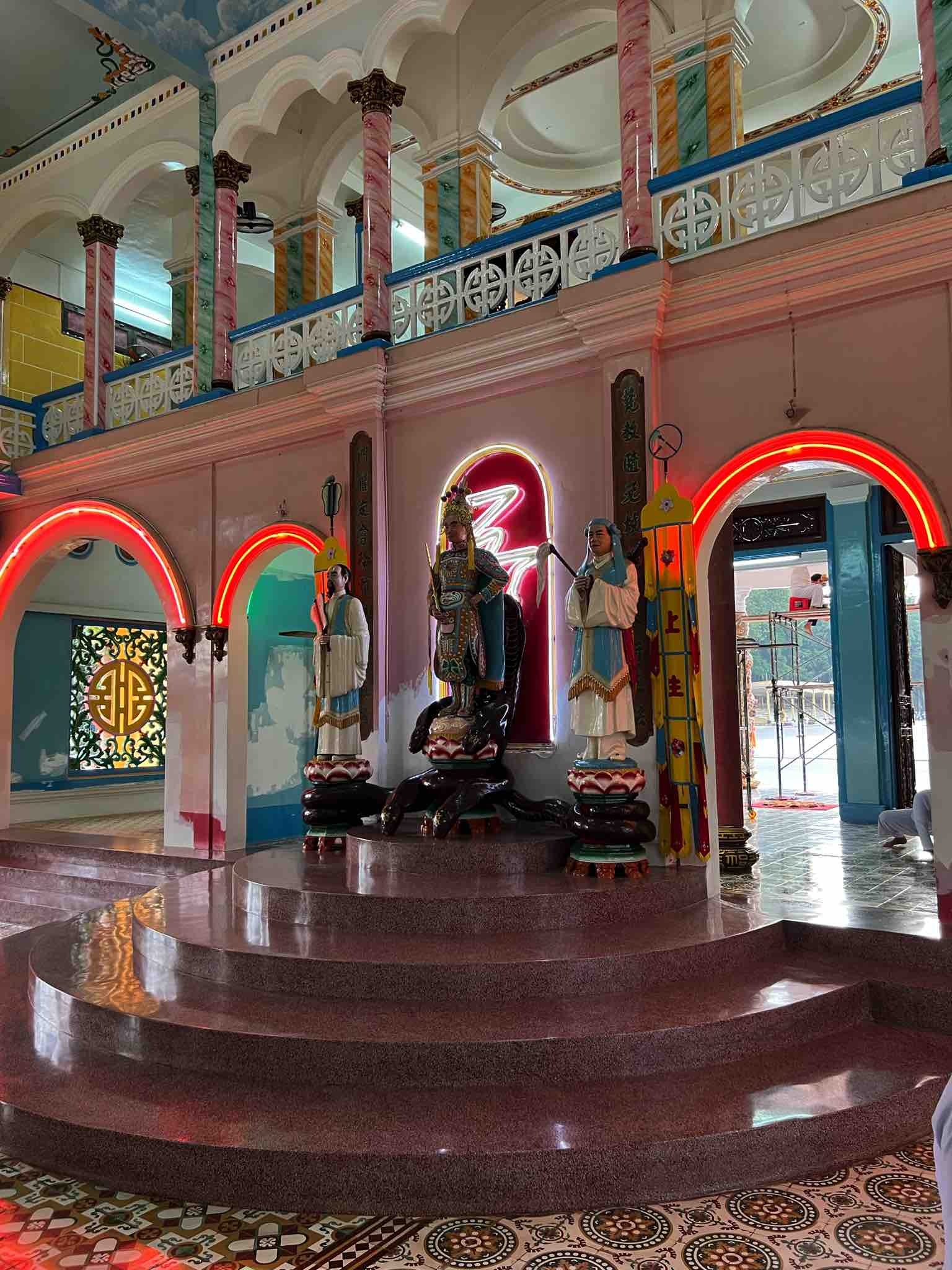
Caodaism quickly gained a large number of followers, especially in the south of Viet Nam, and to this day remains one of the most unique religions in the world, combining both mysticism and structures resembling a church organization. Today, Cao Dai in Viet Nam has about 2 million followers. Despite restrictions, the religion continues to practice and influence the Vietnamese community. Cao Dai temples are visited by believers who practice rituals, prayers, and celebrations. The central place of worship has become the Great Cao Dai Temple in Tây Ninh Province, which remains the spiritual heart of the religion and its administrative center to this day.
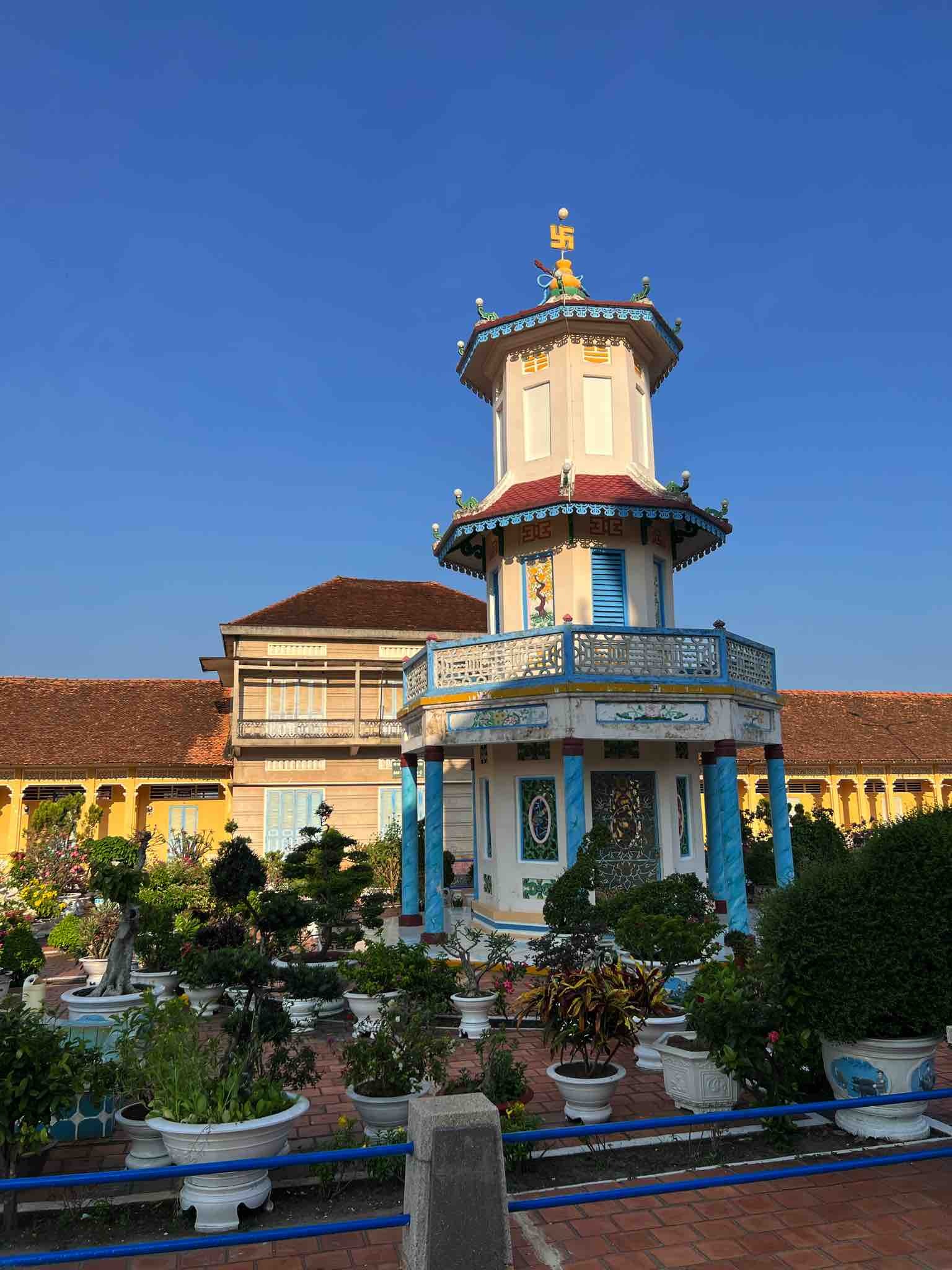
Architecture and symbolism of Caodaist temples
When I arrived, renovations were underway. Locals were painting the ornaments, walls, and columns, and repairing the roof. They do everything themselves, and I was really impressed by the bamboo scaffolding. It's a great, durable, and locally available scaffolding material. Great.
Caodaist temples are distinguished by their unique architectural style, which combines elements of Buddhist pagodas, Christian cathedrals, and Taoist temples. The most characteristic feature of the temples is their colorful facade, decorated with rich ornamentation and symbols referring to different religious traditions.
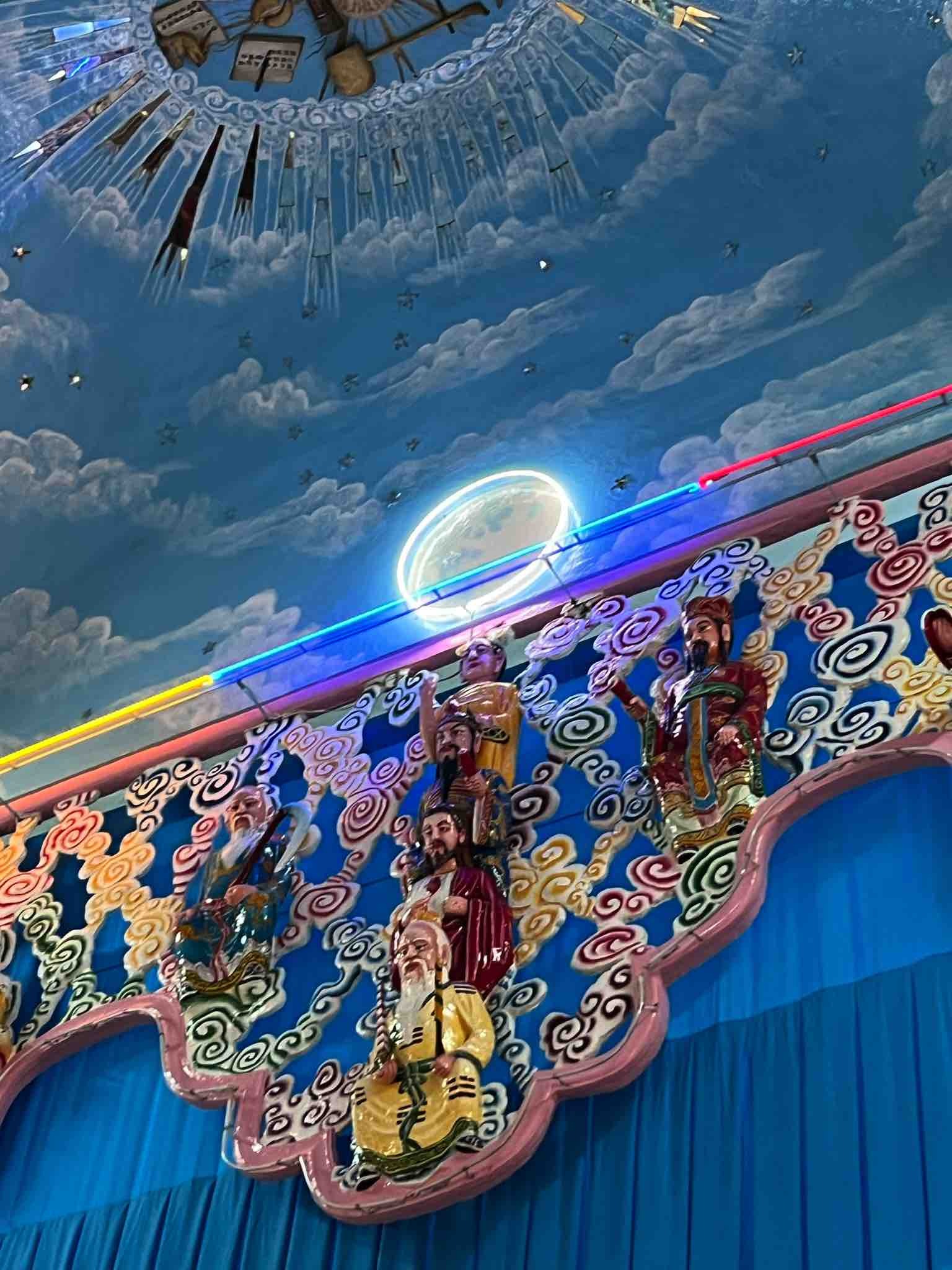
The most important architectural elements:
- All-Seeing Eye (Thiên Nhãn) – symbolizes divine omnipotence and wisdom. It is usually placed on the main altar and in the central place of the temple.
- Columns entwined with dragons – symbolize spiritual strength and wisdom. Dragons are considered guardians of the temple and beings connecting heaven and earth.
- Colors of temples – Each color in Cao Dai temples has its own meaning:
- Yellow represents Buddhism and enlightenment,
- Blue refers to Taoism and harmony,
- Red symbolizes Confucianism and justice.
- Nine-step altar – symbolizes nine levels of spiritual initiation and the soul's striving for divine unity.
- Statues and frescoes depicting prophets – in temples you can find images of Buddha, Confucius, Jesus Christ, Lao Tzu, as well as Western figures such as Victor Hugo, who are believed to have played a role in the development of Cao Dai.

Temples are usually oriented to the east, symbolizing new beginnings and spiritual light. They are divided into three main sections: an entrance and vestibule for the faithful, a main prayer hall, and an area reserved for the clergy.
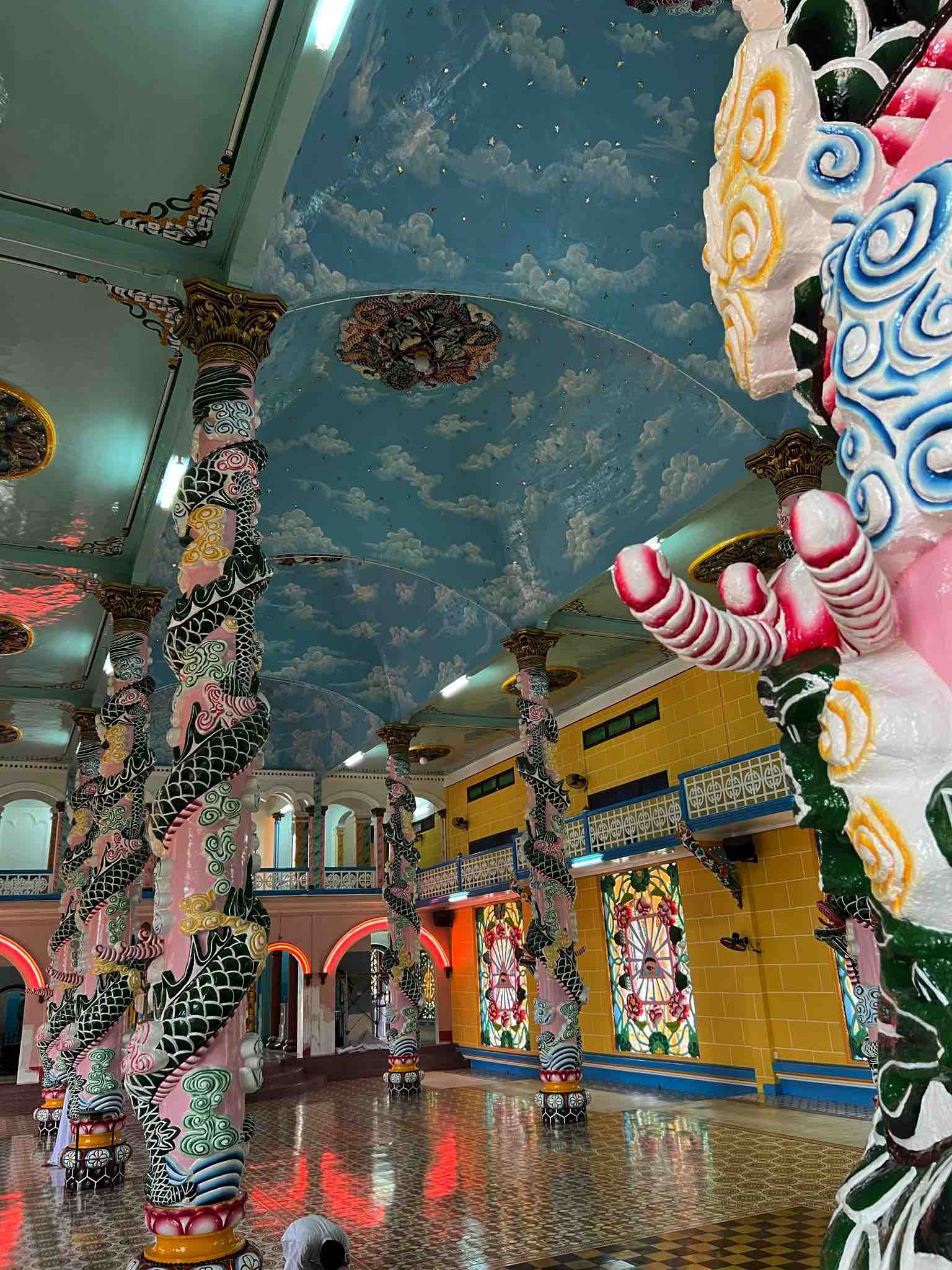
Caodaist rituals and ceremonies
Rituals play a key role in the practice of Cao Dai. The most important ceremonies take place four times a day – at 6:00, 12:00, 18:00 and midnight – and are led by the clergy. During the services, the faithful, dressed in white robes, pray, sing hymns and make offerings of fruit, incense and flowers. Higher-ranking priests wear colourful robes – yellow (Buddhism), blue (Taoism) or red (Confucianism) – to symbolise the diversity of traditions on which the religion is based. The temple is entered without shoes, through separate entrances for women and men. These customs probably come from Islam and Buddhism.
Another important element of the ceremony is séances, during which the faithful try to contact spirits and receive spiritual guidance. In the past, these revelations were crucial to the development of Cao Dai doctrine.
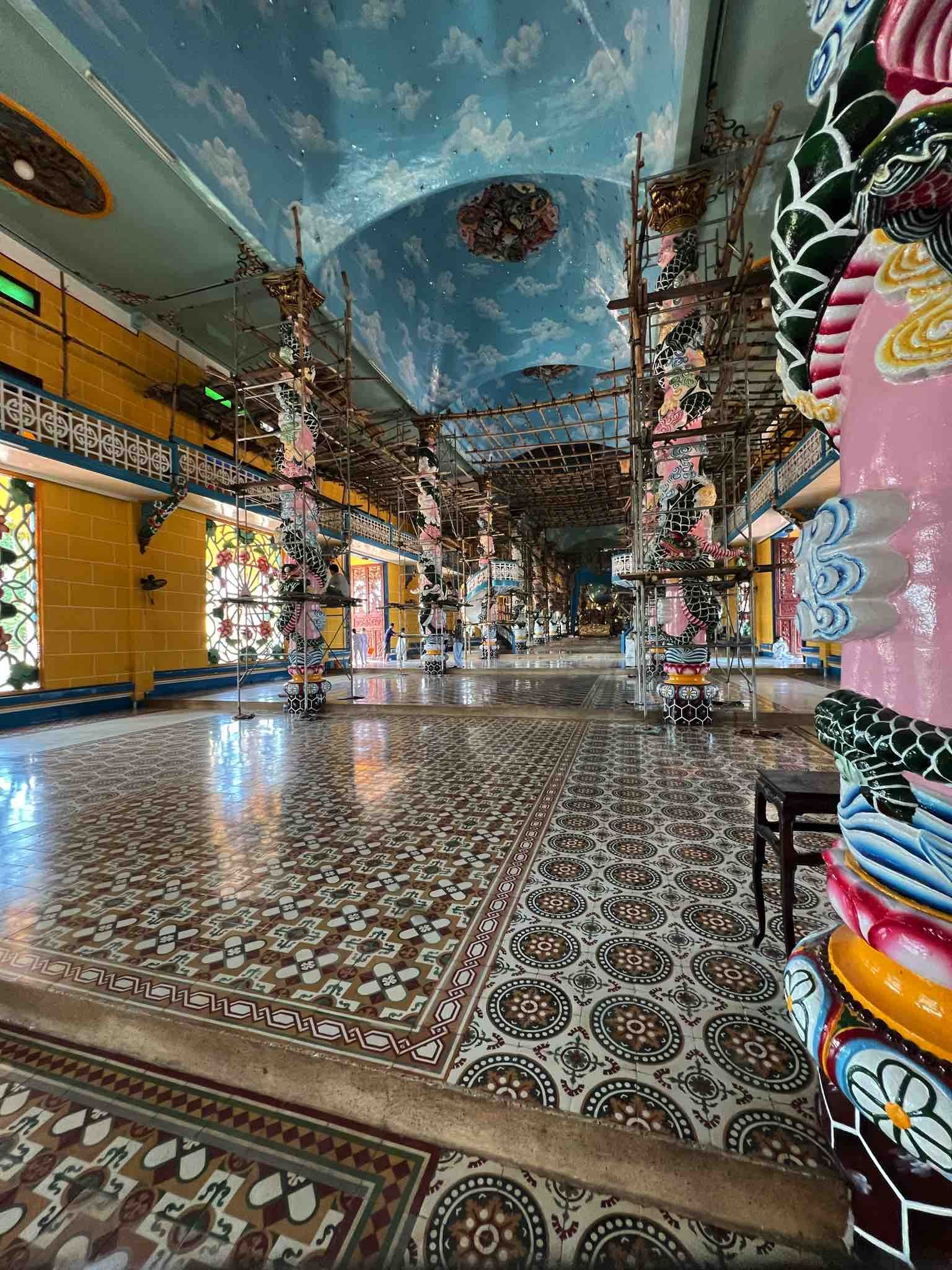
The construction of Caodaist temples
The construction of Cao Dai temples is subject to strict rules that reflect the spiritual values of the religion. Each temple must be oriented towards the east, symbolizing new life and enlightenment. The interiors are richly decorated, and their layout corresponds to the spiritual hierarchy - from the entrance for the faithful to the central altar for the priests.
The most important place is the main prayer hall, which houses the all-seeing eye of God and images of the most important prophets. The altar is placed on a platform, emphasizing the spiritual development that every believer strives for. The construction of temples often involves the entire local community, and the materials used in their construction are carefully selected to symbolize the harmony between man and nature.
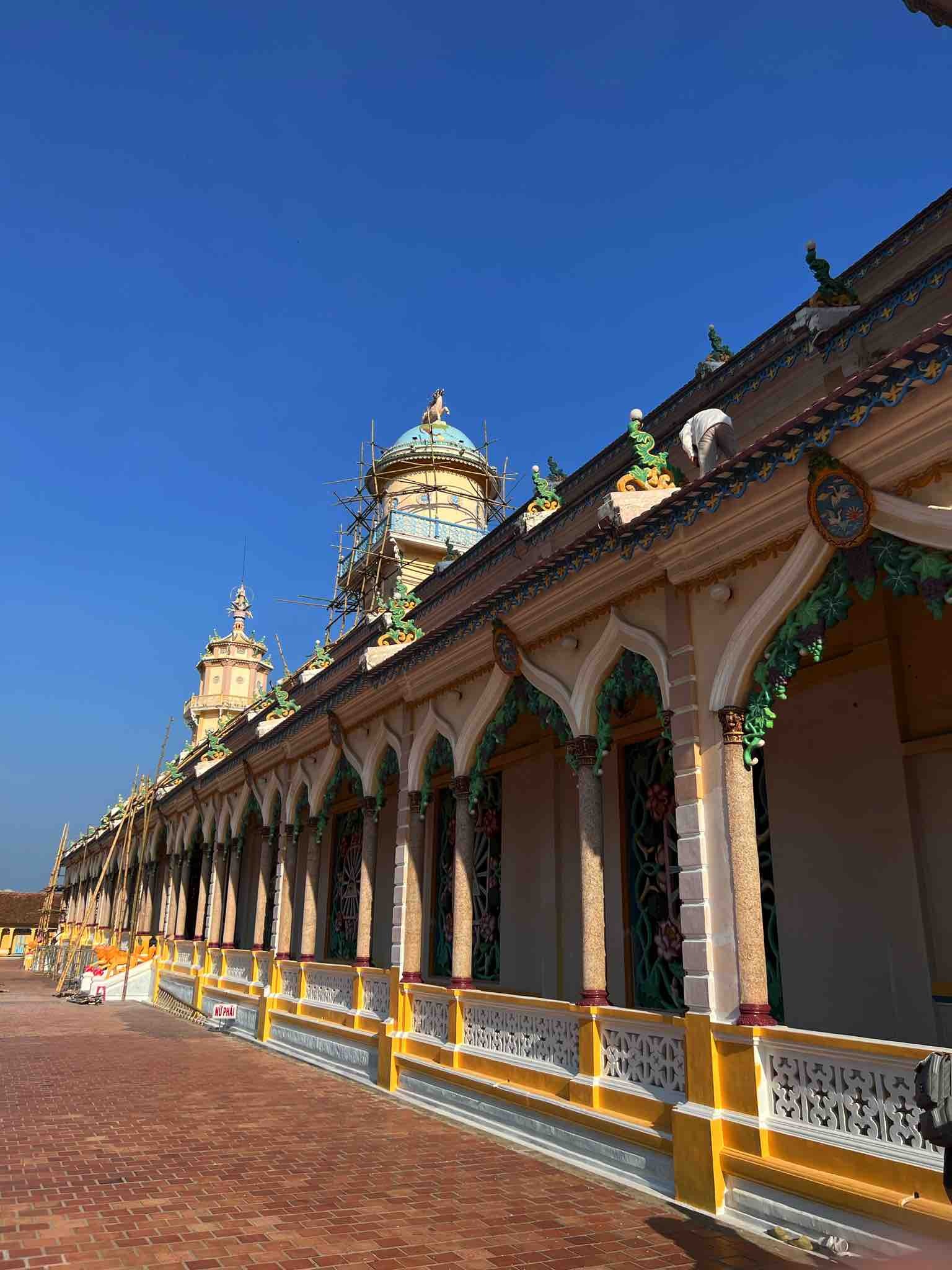
Secrets and Legends of Cao Dai
There are many mystical tales surrounding Cao Dai, and one of the most famous is the legend of the revelation of the All-Seeing Eye. It is said that Ngô Văn Chiêu, the founder of the religion, was meditating when he saw a dazzling light that gradually took the form of an all-seeing eye surrounded by an aura of divine power. A voice from the afterlife told him to spread the message of unity and spiritual enlightenment. This eye later became the religion’s central symbol, reminding the faithful of the constant presence of God.
Another legend tells of spirit guides who visited temples during spiritualist rituals. Great historical figures such as Victor Hugo and Sun Yat-sen were believed to have transmitted spiritual teachings through mediums, guiding the faithful to understand the mysteries of the universe.
One of the more mysterious stories concerns the Great Cao Dai Temple itself. Its construction was said to have been foretold by a spiritual revelation, and its location was to be designated by a sign in the sky. The night before construction began, a golden dragon-shaped light was said to have appeared in the sky, indicating the exact location of the future temple. Local priests saw this as divine intervention and began work immediately.
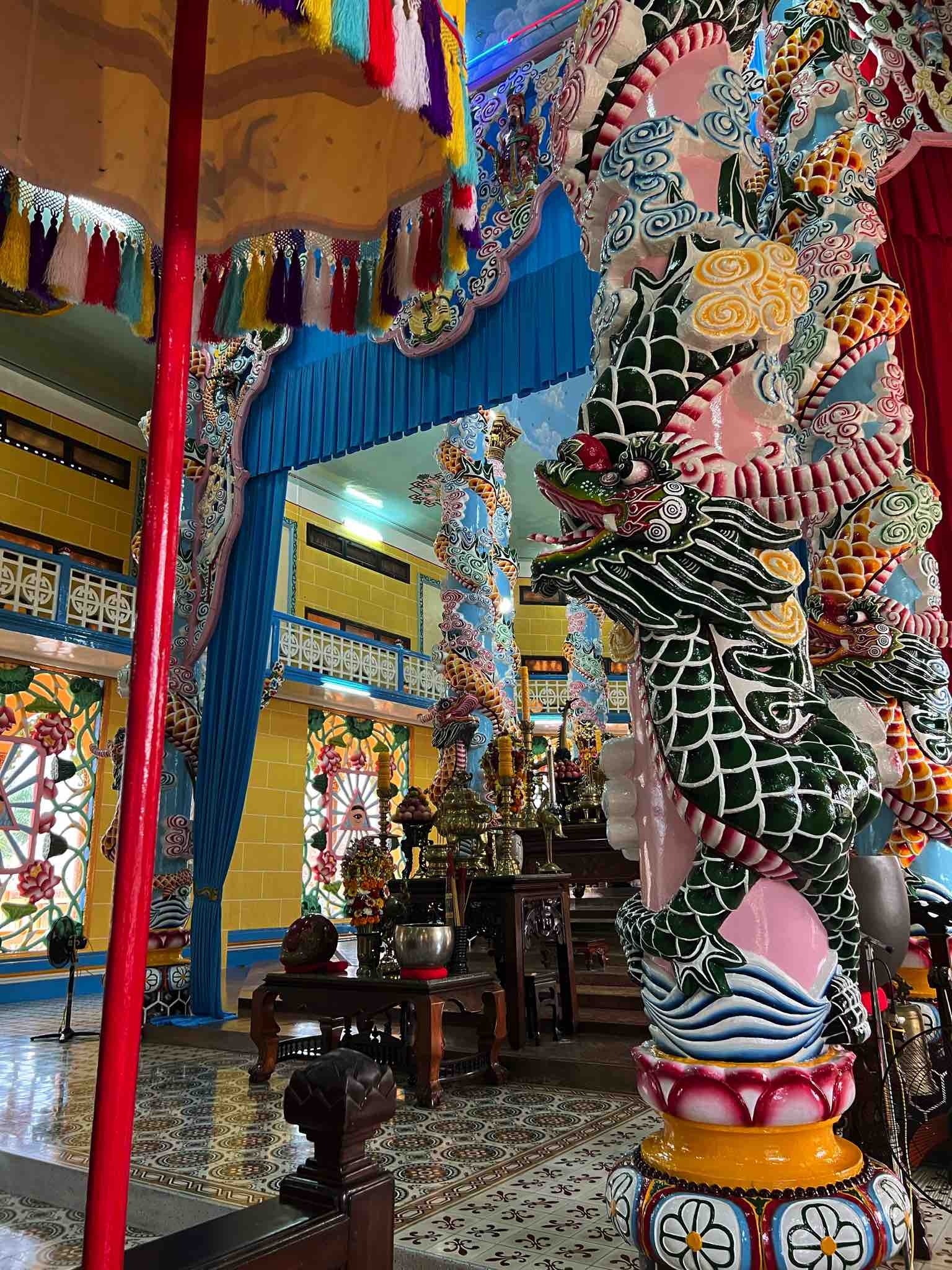
How to get to Cao Dai Grand Temple from Ho Chi Minh City?
The Grand Cao Dai Temple is located about 90 km northwest of Ho Chi Minh City. Here are a few ways to get there:
1. Public transport – bus
The cheapest option is bus 702, which departs from Bến Thành bus station in central Ho Chi Minh City. The journey takes about 3 hours and costs around 20,000-50,000 VND. The bus stops in Tây Ninh, where you can take a taxi or mototaxi (about a 10-15 minute ride) directly to the temple.
2. Renting a scooter
If you prefer more freedom, renting a scooter is a great option. A scooter rental for the day costs around 150,000-250,000 VND. The route takes you through scenic landscapes and the journey takes about 2-2.5 hours. However, it is worth remembering that traffic in Viet Nam can be chaotic, so this option is recommended for more experienced drivers.
3. Private taxi or rental car
The most convenient, but also the most expensive option is to rent a taxi or a car with a driver. The price for a one-way trip is from 800,000 to 1,500,000 VND, depending on the negotiations and the transport company. The travel time is about 2 hours.
4. Organized tour
Many travel agencies in Ho Chi Minh City offer full-day tours to Tây Ninh, often combined with a visit to the Cu Chi Tunnels. The cost of such a tour usually ranges from 300,000 to 700,000 VND and includes transport, a guide, and entry to the temple.
Best Time to Visit Tây Ninh
The best time to visit Tây Ninh Province is during the dry season, which runs from December to April. This period offers pleasant temperatures and little rainfall, making it easy to travel and explore the area. If you’re looking to attend a major religious event, the annual Grand Cao Dai Festival (Đại Lễ Hội Yên) is worth a visit, which takes place in January or February.
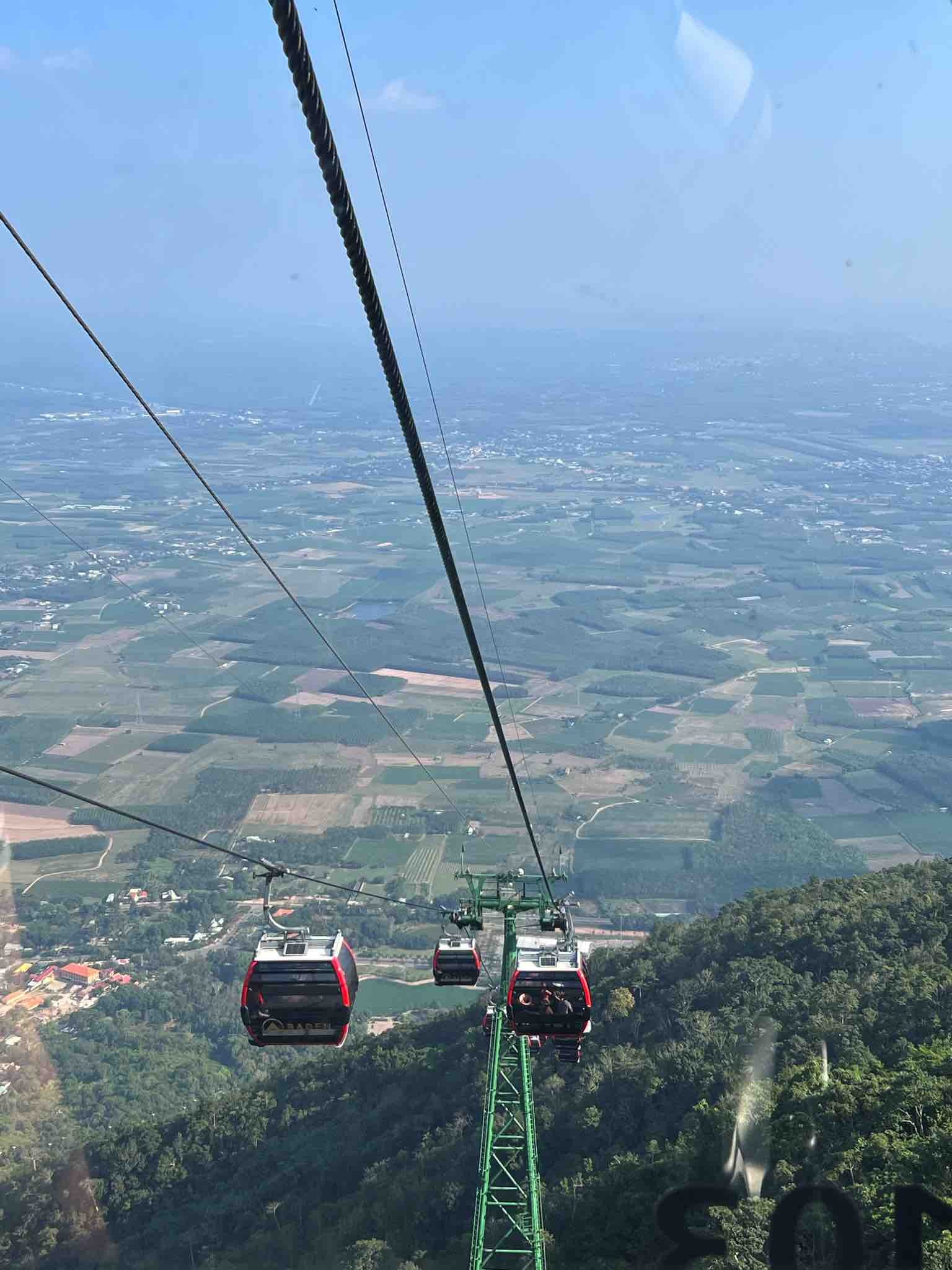
Attractions around Tây Ninh
1. Mount Bà Đen (Black Mountain), which I mentioned earlier
This is the highest mountain in southern Viet Nam (996 m above sea level), often called the “Roof of the South”. You can climb it on foot or by cable car. There is a pagoda at the top, and the view from the top is spectacular.
2. Cu Chi Tunnel
Located about 60 km from Tây Ninh, the Cu Chi Tunnels are a network of underground passages used by the Viet Cong guerrillas during the Viet Nam War. It is a great opportunity to learn about history and see what life was like for soldiers in hiding.
3. Lò Gò – Xa Mát National Park
Located near the Cambodian border, this national park is a paradise for nature lovers. You can see a variety of birds, monkeys and tropical plants here. It is also a great place for trekking and jungle exploration.
4. Tây Ninh Market
A great place to sample local specialities like bánh tráng phơi sương (delicate grilled rice cakes) and a variety of seafood dishes, the market is bustling with activity and offers an authentic Vietnamese culinary experience.
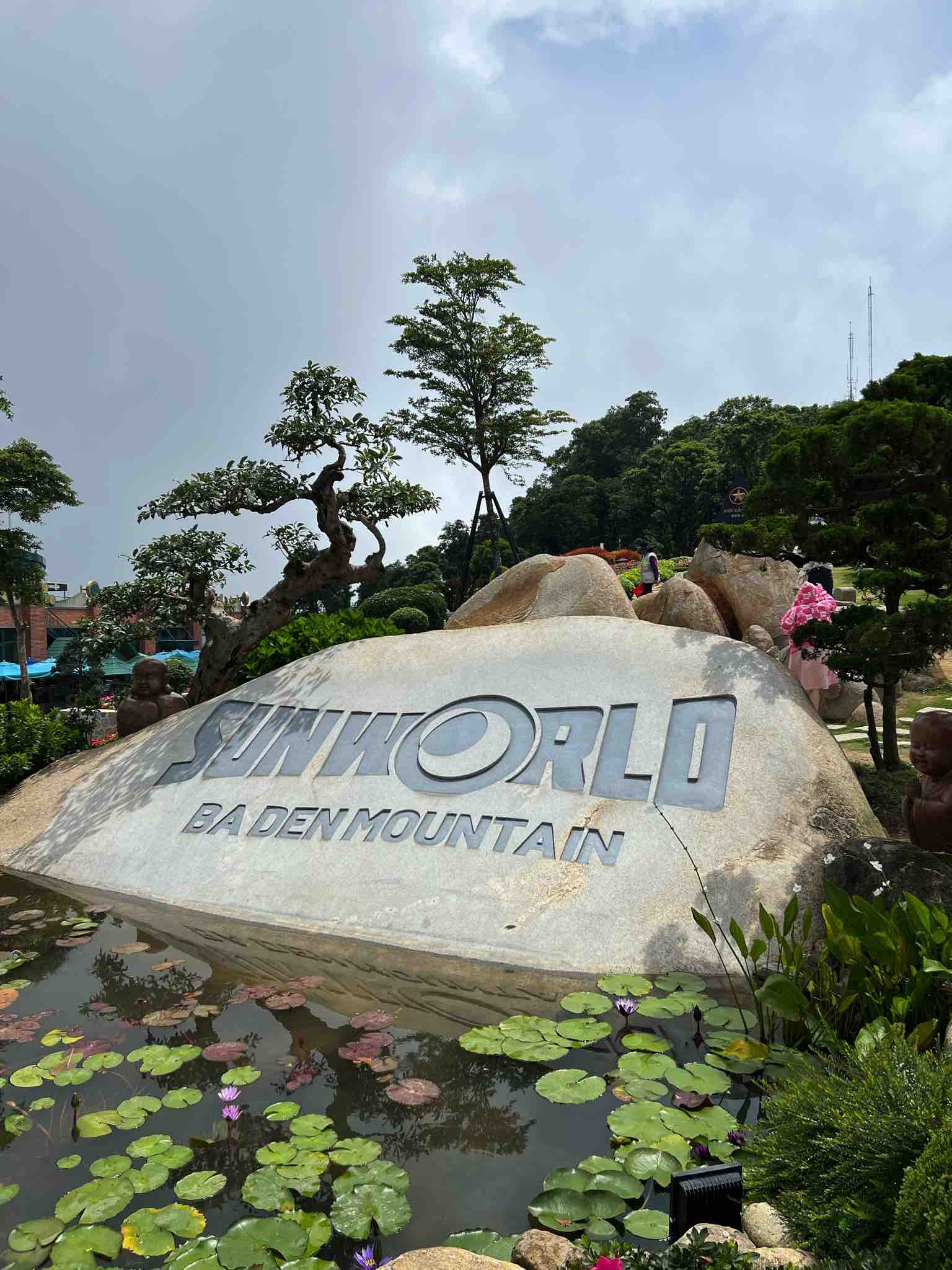
Vietnam in the Color of Spirituality
A visit to the Great Cao Dai Temple is a fascinating spiritual and cultural experience. With its extraordinary architecture, colourful ceremonies and profound symbolism, this temple is one of the most unique landmarks in Viet Nam. If you have time, you can also explore nearby attractions such as Bà Đen Mountain and the Cu Chi Tunnels to fully explore the charms of Tây Ninh Province.
Whether you choose to travel by bus, scooter or as part of an organised tour, this trip is sure to leave an unforgettable impression.
Travel, discover, understand – Asia is waiting...
to show you the wealth of cultures and religions that will enrich your life!
More articles


Pages created with WebWave





















